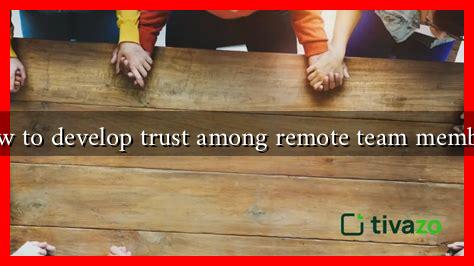-
Table of Contents
How to Develop Trust Among Remote Team Members
In today’s digital age, remote work has become a norm rather than an exception. As organizations adapt to this new landscape, building trust among remote team members is crucial for fostering collaboration, enhancing productivity, and ensuring overall team success. This article explores effective strategies to cultivate trust in remote teams, supported by research, examples, and actionable insights.
The Importance of Trust in Remote Teams
Trust is the foundation of any successful team, but it becomes even more critical in a remote setting. According to a study by the Harvard Business Review, teams with high trust levels are 50% more productive and 76% more engaged. When team members trust each other, they are more likely to share ideas, provide constructive feedback, and collaborate effectively.
Strategies to Build Trust in Remote Teams
Building trust among remote team members requires intentional effort and strategic approaches. Here are some effective strategies:
- Foster Open Communication: Encourage team members to share their thoughts, concerns, and ideas openly. Utilize various communication tools like Slack, Microsoft Teams, or Zoom to facilitate discussions. Regular check-ins can help maintain transparency and keep everyone aligned.
- Set Clear Expectations: Clearly define roles, responsibilities, and goals for each team member. When everyone knows what is expected of them, it reduces ambiguity and builds accountability.
- Encourage Social Interactions: Create opportunities for team members to connect on a personal level. Virtual coffee breaks, team-building activities, or informal chat channels can help strengthen relationships and foster camaraderie.
- Be Transparent: Share information about company updates, project statuses, and challenges openly. Transparency builds trust as team members feel included and valued in the decision-making process.
- Recognize and Celebrate Achievements: Acknowledge individual and team accomplishments regularly. Celebrating milestones, no matter how small, reinforces a sense of belonging and appreciation.
Case Studies: Successful Remote Teams
Several organizations have successfully built trust among their remote teams, serving as excellent case studies:
- GitLab: As a fully remote company, GitLab emphasizes transparency and communication. They maintain an open handbook that details every aspect of their operations, allowing team members to access information freely. This practice has fostered a culture of trust and collaboration.
- Buffer: Buffer is known for its commitment to transparency and employee well-being. They share their revenue, salaries, and even their hiring process publicly. This level of openness has helped build trust among team members and with their audience.
Statistics on Remote Work and Trust
Understanding the dynamics of remote work can provide valuable insights into the importance of trust:
- According to a survey by Buffer, 20% of remote workers struggle with loneliness, which can hinder trust-building efforts.
- A study by Owl Labs found that 77% of remote workers feel more productive when they can work from anywhere, highlighting the need for trust in managing performance.
Tools to Enhance Trust Among Remote Teams
Utilizing the right tools can significantly enhance trust-building efforts. Consider the following:
- Project Management Tools: Tools like Trello, Asana, or Monday.com help keep everyone on the same page regarding project progress and responsibilities.
- Video Conferencing Software: Regular face-to-face interactions through platforms like Zoom or Google Meet can help humanize remote interactions and build rapport.
- Feedback Tools: Platforms like 15Five or Officevibe allow team members to provide and receive feedback, fostering a culture of continuous improvement and trust.
Conclusion
Building trust among remote team members is essential for fostering a collaborative and productive work environment. By fostering open communication, setting clear expectations, encouraging social interactions, and utilizing the right tools, organizations can create a culture of trust that transcends geographical boundaries. As remote work continues to evolve, prioritizing trust will be key to achieving long-term success.
For further reading on building trust in remote teams, consider exploring resources from Harvard Business Review and Buffer’s State of Remote Work report.

